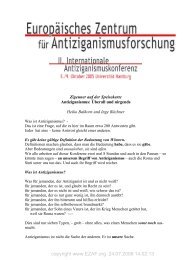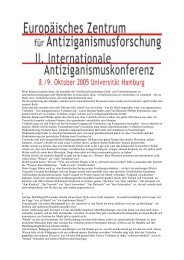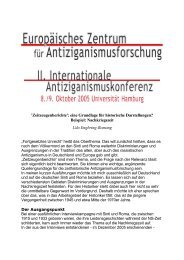Gypsies, Tramps and Thieves: The Portrayal of Romani People in ...
Gypsies, Tramps and Thieves: The Portrayal of Romani People in ...
Gypsies, Tramps and Thieves: The Portrayal of Romani People in ...
Create successful ePaper yourself
Turn your PDF publications into a flip-book with our unique Google optimized e-Paper software.
<strong>Romani</strong> people <strong>and</strong> Travellers we may assume that the same observation also applies here.<br />
“war” on “gypsies free-for-all”<br />
In March 2005, the Sun opened with the headl<strong>in</strong>e, “Sun war on gypsies free for all”. Underneath, the<br />
newspaper wrote <strong>in</strong> huge, red capitals, “Meet your neighbour”, <strong>and</strong> cont<strong>in</strong>ued <strong>in</strong> small letters “… thanks to<br />
John Prescott”. <strong>The</strong> text was set <strong>of</strong>f by the photograph <strong>of</strong> two caravan trailers with a bunch <strong>of</strong> men stroll<strong>in</strong>g<br />
around. A smoke screen <strong>in</strong> the background completed a picture <strong>of</strong> desolation rem<strong>in</strong>iscent <strong>of</strong> a civil war.<br />
This was not the Sun’s first crusade aga<strong>in</strong>st <strong>Romani</strong> people <strong>and</strong> Travellers. One year before, Roma from<br />
Eastern Europe were the targets <strong>of</strong> the Sun <strong>and</strong> other British tabloids, which announced that 1,6 million Roma<br />
would be wait<strong>in</strong>g to “<strong>in</strong>vade” the British Isles after the entry <strong>of</strong> the central <strong>and</strong> east European states <strong>in</strong>to the<br />
EU.<br />
Are the media biased aga<strong>in</strong>st Roma? A 2004 survey on m<strong>in</strong>orities <strong>in</strong> the media concluded: “S<strong>in</strong>ti <strong>and</strong><br />
Roma/Travellers are the group most <strong>of</strong>ten portrayed negatively”. It found that <strong>in</strong> one third <strong>of</strong> the articles<br />
analysed, the portrayal <strong>of</strong> S<strong>in</strong>ti <strong>and</strong> Roma was negative <strong>and</strong> <strong>in</strong> half <strong>of</strong> the cases it was neutral. 5<br />
<strong>The</strong> author noticed that neutral report<strong>in</strong>g is more frequent for people from different ethnic groups which “may<br />
<strong>in</strong>dicate a lower threshold for mention<strong>in</strong>g ethnicity” <strong>in</strong> the case <strong>of</strong> the Roma <strong>and</strong> “a higher probability <strong>of</strong> this<br />
group appear<strong>in</strong>g <strong>in</strong> news associated with negative facts, or the existence <strong>of</strong> more negative <strong>and</strong> persistent<br />
stereotypes about S<strong>in</strong>ti <strong>and</strong> Roma.” 6<br />
In the follow<strong>in</strong>g article, I look <strong>in</strong>to the portrayal <strong>of</strong> <strong>Romani</strong> people <strong>and</strong> Travellers <strong>and</strong> the images they suggest.<br />
Over several months, I followed report<strong>in</strong>g on Roma us<strong>in</strong>g the Internet as a ma<strong>in</strong> source. I analysed articles,<br />
which I found via the Google news search eng<strong>in</strong>e, but I have also used the archives <strong>of</strong> different newspapers<br />
<strong>and</strong> magaz<strong>in</strong>es.<br />
I have concentrated on English, French <strong>and</strong> German media, which implies that the scope <strong>of</strong> my f<strong>in</strong>d<strong>in</strong>gs is<br />
necessarily limited. Journalistic codes <strong>of</strong> conduct <strong>and</strong> practice vary from country to country, which also has an<br />
impact how ethnic m<strong>in</strong>orities are portrayed. As regards the <strong>Romani</strong> people this concerns also the use <strong>of</strong><br />
term<strong>in</strong>ology where the same term<strong>in</strong>ology may appear as acceptable <strong>in</strong> one country <strong>and</strong> not acceptable <strong>in</strong> the<br />
other.<br />
Talk<strong>in</strong>g about differences it is furthermore important to notice that there is another common difference between<br />
<strong>in</strong>ter/national <strong>and</strong> regional/local media <strong>and</strong> the broadsheet <strong>and</strong> tabloid press. While the former may appear<br />
more objective, concentrat<strong>in</strong>g on issues such as the social marg<strong>in</strong>alisation <strong>and</strong> discrim<strong>in</strong>ation <strong>of</strong> <strong>Romani</strong><br />
people, the latter frequently associate Roma with trouble-mak<strong>in</strong>g <strong>and</strong> crime. Though the sample used for this<br />
research does not provide sufficient evidence for this type <strong>of</strong> statement it may be assumed that the ideological<br />
orientation <strong>of</strong> a newspaper has a lesser impact.<br />
Generally speak<strong>in</strong>g it is possible to identify common patterns with regard to the way S<strong>in</strong>ti <strong>and</strong> Roma are<br />
represented <strong>in</strong> the media: they have their orig<strong>in</strong> <strong>in</strong> the prevail<strong>in</strong>g stereotypes <strong>and</strong> racist prejudices aga<strong>in</strong>st<br />
<strong>Romani</strong> people, which are shared <strong>and</strong> reproduced by the media. Many <strong>of</strong> these patterns may also be found <strong>in</strong><br />
report<strong>in</strong>g about other groups such as refugees <strong>and</strong> asylum seekers or non-EU immigrants. What seems to<br />
dist<strong>in</strong>guish negative report<strong>in</strong>g on <strong>Romani</strong> people from negative report<strong>in</strong>g on other ethnically def<strong>in</strong>ed groups is<br />
was even higher: 44 percent for readers <strong>of</strong> the Daily Mail <strong>and</strong> the Mail on Sunday <strong>and</strong> 43 percent for the readers <strong>of</strong> the Sun <strong>and</strong><br />
News <strong>of</strong> the World expressed negative views. Inversely, the researchers found that readers <strong>of</strong> the Guardian <strong>and</strong> the Observer<br />
would be the less likely to express prejudice aga<strong>in</strong>st refugees/asylum seekers (15 percent).<br />
5 Jessika ter Wal: Quantitative analysis <strong>of</strong> daily press <strong>and</strong> TV contents <strong>in</strong> the 15 EU Member States, March 2004, at:<br />
http://www.multicultural.net/edmm/edmm_eureport.pdf<br />
6 ibid.





